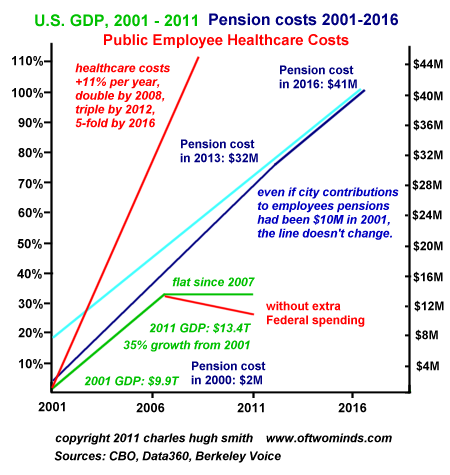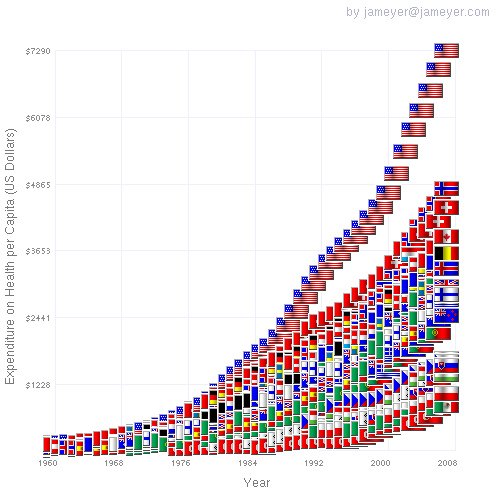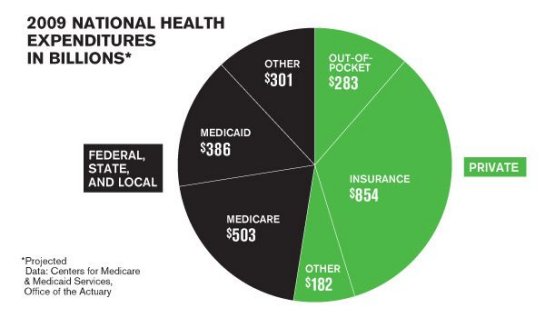Sickcare Will Bankrupt the Nation--And Soon
The costs of the U.S. "healthcare" system, a.k.a. sickcare, are rising at a rate that is three to five times faster than the growth of the GDP--when it's growing at all. That guarantees sickcare will bankrupt the nation within a few years. Forget the Pentagon and welfare: what will soon bankrupt the nation is our out-of-control malignant sickcare system, a.k.a. "healthcare." The runaway costs of "healthcare" are undermining the nation's economy on multiple levels. The people actually providing the care know the system is broken. It's not "fixable" via minor policy tweaks or limiting payments to one slice of providers; the problem is systemic. The country is in a tizzy over public employee bargaining rights and compensation costs, but few ask this question: What is the biggest cause of public employees compensation soaring to unsustainability? Answer: The costs of providing healthcare, which are rising 6% every year across a flatlined economy, and up to 11% per year for public employees. Here is a chart drawn from Public Pension and Healthcare Costs and Financial Common Sense (February 28, 2011) which depicts how fast-rising pensions and healthcare costs are completely disconnected from the underlying economy. Public employee healthcare costs in some California cities have been rising an average of 11% per year in the decade since 2000. Here is what happens to $1 in healthcare costs which increase 11% per year: 1 (2001) By 2012, these costs have more than tripled and by 2016 they will have jumped five-fold. Once again: does anyone seriously believe these trends are sustainable in an economy which isn't even growing at all once we subtract Central State borrowing and spending? For context on Central State borrowing (Federal deficits): Here are the deficits of the past three years, and the estimated shortfalls for fiscal years 2011 and 2012: 2008: $458 billion total: $6.258 trillion in five years. While healthcare costs are rising around the developed world due to the demographics of aging and more treatment options, the U.S. sickcare system costs twice as much as our competitors' systems. Medical Care Prices Are Rising Faster Than Overall Inflation (BusinessWeek) The source of the problem is the "fee for service" foundation of the system. There are no real limits on spending, despite various "reforms" which attempt to limit the runaway costs. Correspondent Quentin VT submitted this article from The New York Times on CEOs of publicly funded hospitals drawing millions of dollars a year in compensation: Immune to Cuts: Lofty Salaries at Hospitals. I have covered these issues in depth for years: Healthcare "Reform": the State and Plutocracy Stripmine the Middle Class (Again)(November 9, 2009) The Simulacra of Change, the Propaganda of Hope (January 20, 2010) Is Fee-for-Service What Ails America's Health Care System? (January 18, 2010) Can Health Care Reform Possibly Control Costs? (April 10, 2011) Sickcare is fundamentally a system of interlinked politically powerful cartels. Insiders who refuse to speak on the record for fear of antagonizing the powers that be, exorbitant price increases, confidential agreements and a tug-of-war between warring tribes. Is this the Mafia we're talking about? From the point of view of investigative journalism, it could also describe America's health care industry. Setting aside the politically attractive mantra of "improving access to healthcare," from this point of view the industry is a highly profitable and politically powerful group of companies which operate in cartel-like fashion: that is, they use their clout to limit competition and establish highly profitable pricing. These observers use the word "cartel" not in the sense of a formal organization like OPEC (the Organization of the Petroleum Exporting Countries) or the criminal activities of drug cartels, but in the informal sense of a small group of companies which dominate specific markets and thus wield significant political and pricing power within those markets. Why should we care? Experts say that it is a sign of the medical industry's enormous political power that the health reform bill overlooked some of the biggest cost drivers in American medicine. And if costs don't go down, then the affordability and sustainability of the U.S. healthcare system become questionable over the long-term. The U.S. already spends twice as much as other developed countries on healthcare as a percentage of GDP. When asked to identify the source of America's runaway health care costs -- U.S. spending on health care has more than doubled as a share of GDP in the past 30 years -- healthcare industries and trade groups excel at pointing to the next guy as the source. Doctors, hospitals, insurers, HMOs, pharmaceutical companies, malpractice lawsuits and the courts which award huge settlements, Federal regulatory agencies, Medicare--scapegoats abound, and so do rationalizations. If no one industry is responsible, then perhaps we need to look at the entire system of self-serving industries which profit from guaranteed payments to private-sector corporations which involve special political dispensations such as exemptions from anti-trust laws, and a tolerance for ways of limiting competition and insuring highly profitable contracts. If the healthcare reform bill doesn't really address the cost drivers and the incentives built into the current system, then it's difficult to see how costs can decline. This system is based on regional networks of providers negotiating with insurers to exclude competitors and set exorbitant prices that are passed on as insurance premiums. While insurers complain about rising costs, they are exempt from antitrust laws and thus they have the power to consolidate smaller insurers within a region and then pass on price increases to consumers and businesses alike. A recent report by Massachusetts Attorney General Martha Coakley uncovered multiple forms of anti-competitive behavior among providers, including huge price disparities that had no visible relation to any free-market factors. The report concluded that this and other forms of collusive behavior were "pervasive." Once upon a time in U.S. healthcare, it was the norm to post prices for procedures and care; this is no longer the norm. Some local providers who post their prices openly, such as Keith Smith, an anesthesiologist with the Oklahoma Surgery Center, find that preferred provider organizations (PPOs) and insurance companies aren't interested in contracting with his group, even though their prices are 70% less than those charged by local not-for-profit hospitals. To Smith, that is strong evidence that medical cartels are making deals with insurers to monopolize services in their region. To cite another example of the distortions which end up costing the nation twice as much for health care (as a percentage of GDP) as competing developed countries such as Australia and Japan: Pittsburgh has almost as many MRI machines as the nation of Canada. According to local media reports, Western Pennsylvania has about 140 MRI machines, while the 32 million residents of Canada share 151 MRI machines. And the machines are getting a lot of use: the number of CT and MRI scans (scans other than old-fashioned X rays) tripled from 85 to 234 per thousand insured people since 1999. While proponents are quick to note that scans are cheaper than the alternative diagnostic procedures, one firm's research found that a doctor who owns his own machineis four times as likely to order a scan as a doctor who doesn't. As if that wasn't enough to highlight the self-serving nature of "fee for service" cartels, MRI scanner manufacturer General Electric waged a two-year lobbying campaign to roll back cuts in Medicare reimbursements for scans. While the effort proved unsuccessful due to the intense political pressure to reduce soaring Medicare costs, some critics claim that providers simply made up the reduced reimbursements by increasing the number of tests administered. The only solution that actually addresses the systemic problem is to get rid of the entire fee-for-service structure and break up the cartels. Healthcare must be reconnected to diet, nutrition, fitness, lifestyle and community, and to education and emotional well-being. The odds of any of this happening are essentially zero, and so we can safely predict that sickcare will bankrupt the nation (with a helping hand from the Pentagon) within a few years. Of Two Minds is also available via Kindle: Of Two Minds blog-Kindle
1.11
1.23
1.37
1.52
1.69
1.87
2.08 (2008)
2.3
2.56
2.84
3.15 (2012)
3.5
3.88
4.31
4.78 (2016)
2009: $1.4 trillion
2010: $1.3 trillion
2011: $1.5 trillion (est.)
2012: $1.6 trillion (est.)

The U.S. spent an estimated $2.4 trillion on health care in 2008, about 16.5% of gross domestic product and a 6% increase from a year earlier. Medical care prices are rising faster than overall inflation, and the burden on consumers continues to grow.
If you would like to post a comment, please go to DailyJava.net.
Order Survival+: Structuring Prosperity for Yourself and the Nation (free bits) (Mobi ebook) (Kindle) or Survival+ The Primer (Kindle) or Weblogs & New Media: Marketing in Crisis (free bits) (Kindle) or from your local bookseller.Thank you, Paul L. ($225), for your unimaginably generous contributions to this site (of garden tools and cash)-- I am greatly honored by your support and readership. Thank you, Clinton S. ($25), for your admirably generous contribution to this site -- I am greatly honored by your support and readership.



























